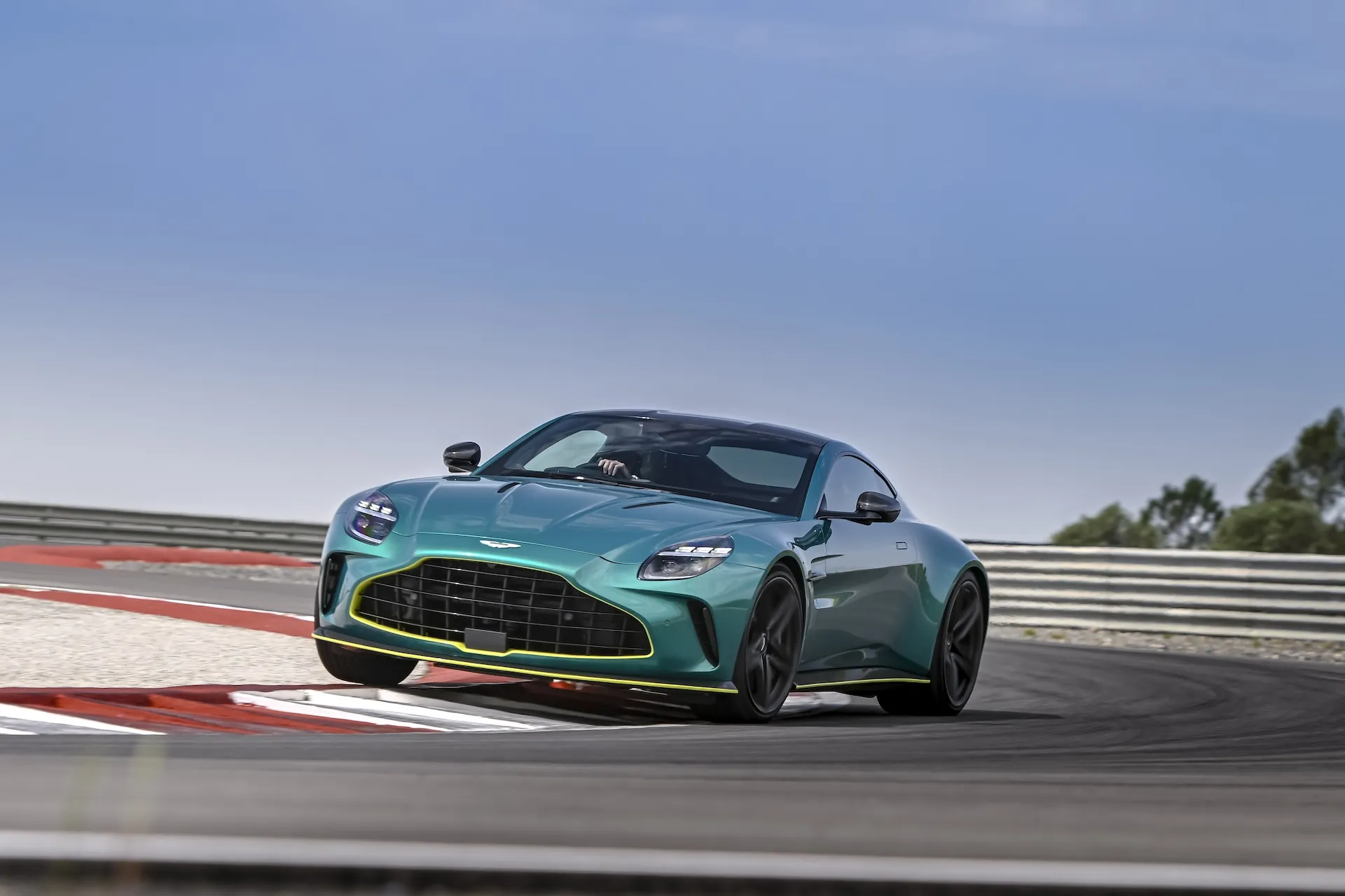Circumstance keeps stacking factors against me. I’m in a short-wheelbase, 656-hp, right-hand-drive sports car on the wet surface of an unfamiliar racetrack, and due to a communication breakdown, the stability control is off. My trepidation runs high behind the wheel of the 2025 Aston Martin Vantage.
Track session 1: Aston Martin Vantage Adjustable Traction Control
A well-meaning but momentarily misinformed Aston Martin technician tells me activating the Adjustable Traction Control system with a long press of the stability control button on the center console provides varying levels of not only traction control but also stability control. I’ve chosen level 3 thinking it would add a little more stability intervention than the base level 5. That’s wrong. The system affects the traction control through eight levels but it turns off stability control.
I’d really rather have active electronic nannies on this slick course at Circuito Monteblanco outside of Seville, Spain.
Otherwise, the car is in the default Sport mode that puts the powertrain, steering, engine sound, and suspension in their mildest settings.

2025 Aston Martin Vantage
My apprehension quickly turns prescient. Heading out on the track, I immediately misjudge the grip, brake too late, and overcook the very first turn, putting two wheels off on a paved runoff area. Oops.
Time to exercise better control because this two-seat sports car has taken a massive leap forward in performance.
It starts with the engine, a familiar Mercedes-Benz AMG-sourced twin-turbocharged 4.0-liter V-8. It spun up 503 hp in the outgoing Vantage, but here it rumbles to the tune of 656 hp and 590 lb-ft of torque. Aston Martin engineers have wrought more power out of the Mercedes engine by teaming bigger turbos with a lower compression ratio, new cam profiles, and better cooling. The changes produce 30% more hp and 15% more torque.
The engine sends its power to a ZF 8-speed automatic rear transaxle that’s been updated with shorter shift times, and it all flows through a shorter 3.08:1 final drive ratio to improve throttle response. An electronic limited-slip differential apportions the power between the rear wheels.
Harnessing all that power proves troublesome in the wet, but I manage to keep the car between the lines for the rest of the run. It requires a delicate throttle pedal because the power comes on fairly early, with peak torque arriving at 2,750 rpm. From there, it builds quickly to the 7,000 rpm redline. This car rockets from 0-60 mph in 3.4 seconds, according to Aston Martin, so I can’t get to full throttle anywhere but in the long straight of this roughly 2.1-mile track. Even easing into the throttle in the wet, the engine has enough gusto to get the car up to 156 mph in the 0.6-mile straight.
Between the power and slick traction, I slip and slide through this session. The power creates enough speed to make braking an adventure in finding grip and maintaining stability. Braking resistance comes on quickly in the pedal travel but without a commensurate amount of stopping power. It feels wooden at first, but from that first resistance it’s easy to modulate the bite in small increments. It’s likely why I missed that first corner, but I soon get used to it and I have no further problems.
I not only slide the car through the corners but also fight a tendency for the rear end to come around—just as I suspected. I go easy enough on it to prevent a spin, but a few spins among my fellow journalists show the Vantage wants to oversteer at the limit, and that limit is rather easy to reach in the wet. Aston Martin says the new Vantage has 12% less understeer (as measured on a skidpad) than the last model. Maybe that’s why it wants to oversteer. I’m looking forward to dry conditions to see if it still wants to spin.

2025 Aston Martin Vantage
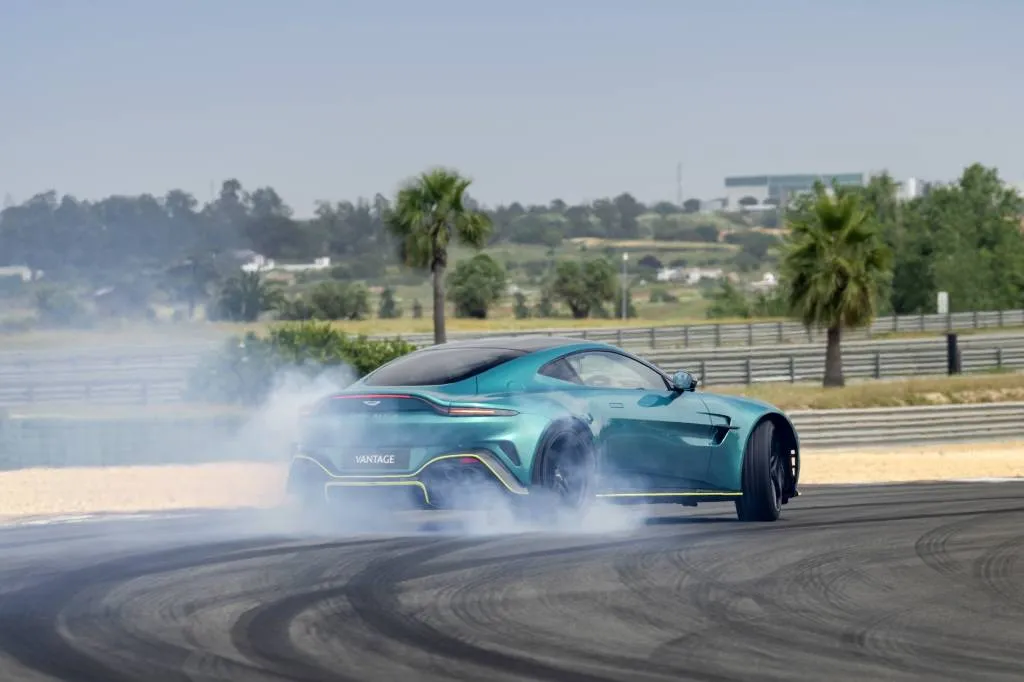
2025 Aston Martin Vantage

2025 Aston Martin Vantage
Track session 2: Aston Martin Vantage Sport mode
Intermittent cloud bursts have made various areas of the track wet again, so this time I’m going with the relative security of the default Sport mode with full traction and stability control.
Some of areas of the track are dry this time around, and I start to get a feel for the Vantage’s rather adept handling.
The Vantage isn’t new for 2025, but it’s significantly updated from the redesigned 2019 Vantage. Its front-mid-engine layout carries over with a rear transaxle and rear-wheel drive to give the car a perfect 50:50 front-to-rear weight balance.
The bonded aluminum architecture also carries over, but Aston Martin’s engineers have strengthened it both overall and in key areas. They moved the front body crossmember rearward to increase the stiffness for the mounting points of the double-wishbone front suspension. They also added a stiffer and lighter front suspension cross brace and reworked the shear panel beneath the engine. Chief engineer Simon Newton told Motor Authority that the changes improve lateral stiffness by 100% at the front crossmember and suspension mounting points, and overall stiffness is up by about 5%.
Aston Martin also sets the car on much wider wheels and tires. It now rides on 275/35R21 front and 325/30R21 rear tires mounted on 9.5-inch wide front and 11.5-inch wide tires. Aston Martin worked with Michelin to create a bespoke set of Pilot Sport S 5 summer tires. The front tires are 20 mm wider and the rears get 30 mm wider. Aston offsets the extra weight of all that rubber by making the wheels from forged aluminum.
The Vantage feels notably stiffer than the last model, with a ride quality that says sports car more than grand tourer. A stiffer steering column, firmer bushings, faster-acting adaptive dampers with greater performance capability, and a quick 12.8:1 steering ratio contribute to sharp turn-in response. The steering also sports some welcome heft and a stable on-center feel.
Still, this track isn’t dry enough, and Sport mode doesn’t maximize performance enough to allow me to approach the car’s speed and handling limits.

2025 Aston Martin Vantage
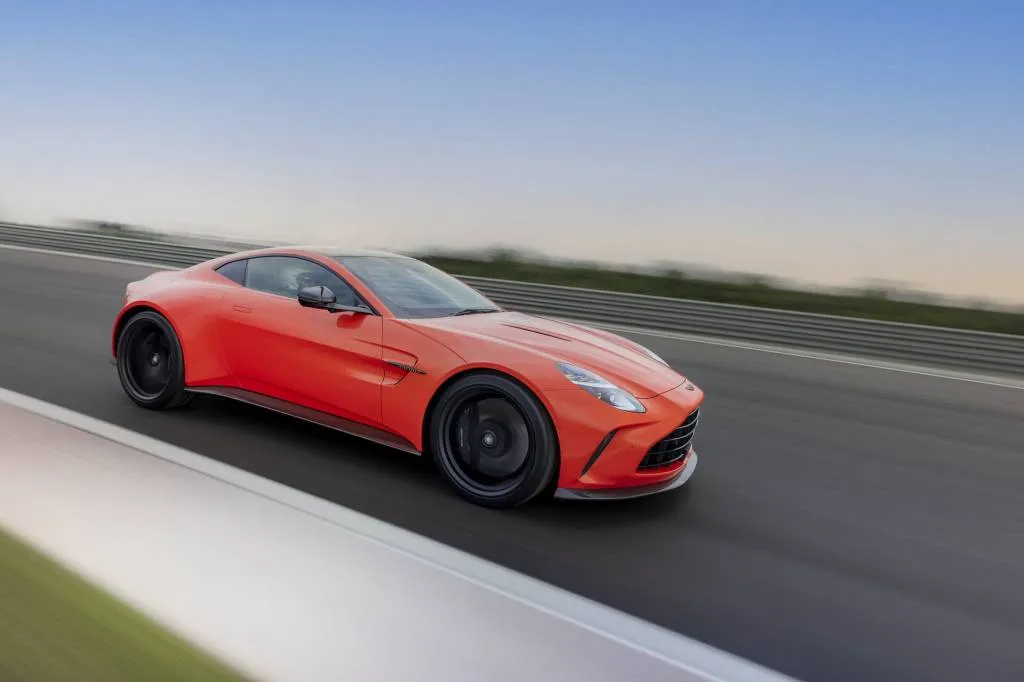
2025 Aston Martin Vantage
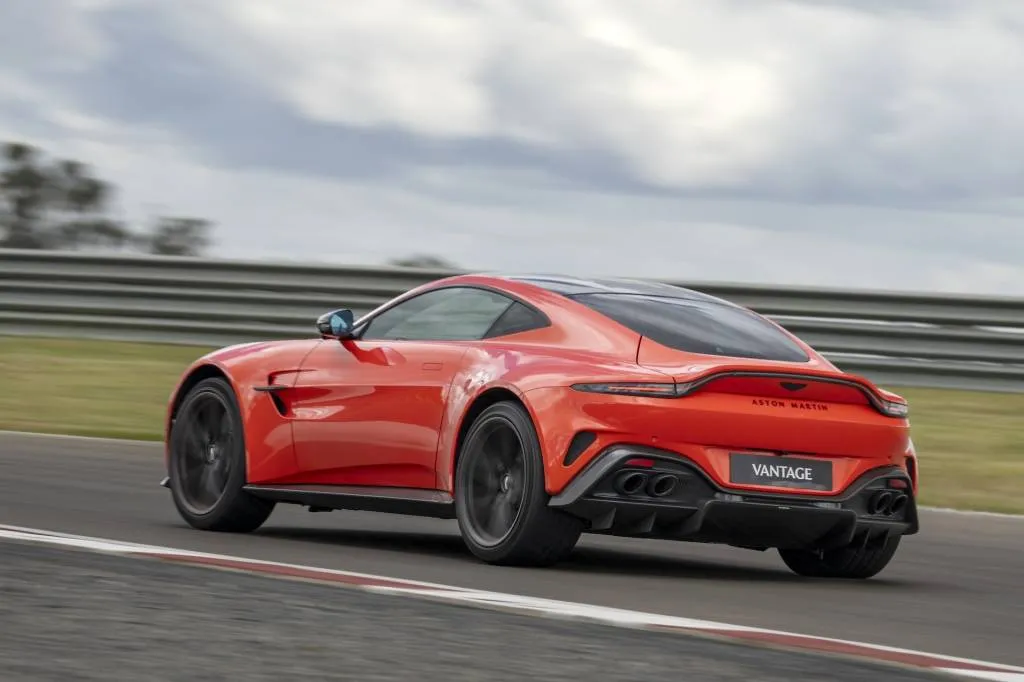
2025 Aston Martin Vantage
Track session 3: Aston Martin Vantage Individual mode
This time I choose the Individual driving mode and the stability control’s Track setting, which requires a five-second press of the stability control button (holding it longer, or a second long press, activates Adjustable Traction Control). Aston Martin has programmed Individual for what I would consider the ideal driving parameters (well, almost): the powertrain at its most extreme Track setting, the dampers at their softest Sport setting to keep the tires on the track in bumpy areas, the exhaust to its loudest Sport+ setting, and the steering to the lighter Sport setting (I’d actually chose the firmer Sport+ for more mid-corner stability).
The tarmac has dried up for my third run, I’ve learned the track layout, and I’m used to driving on the right-hand side. This time I want to get the most out of the car, and I soon find it has a lot to give.
Aston Martin makes sure the almost excessive amount of rubber stays on the pavement through corners with -1.5 degrees of front camber and -1.7 degrees of rear camber. The bespoke tires boast tremendous grip that raises the speeds the Vantage can manage through turns. The 50:50 weight balance provides generally neutral handling, but I’m still careful to ease into the throttle at corner exit to prevent oversteer.
I go hard, though, and it feels like I would have to try to kick out the tail with sudden inputs or excess throttle. It’s easy enough to manage as the steering provides excellent feedback about what those tires are doing, and the electronic limited-slip differential sorts out the power and traction balance to vault the Vantage from one corner to the next.
Aston doesn’t have to resort to advanced technologies like active anti-roll bars or rear-wheel steering to get the most out of the handling. The low-slung, firm suspension keeps the car’s attitude plenty flat in turns and the short wheelbase doesn’t need to get any shorter for quick reactions and crisp rotation.
More confident putting the power down when exiting the last corner, I get a better run through the front straight and take the top speed up to 161 mph. The Mercedes V-8 really makes this baby cook, and on a longer straight it would be capable of reaching 202 mph, according to Aston Martin.
I do run into one slight problem, though. With 20 journalists running three 20-minute sessions, each car has been on the track all day and seen perhaps 50 laps, more than 100 miles, of hard driving, so the brakes have taken quite a beating. The track cars are outfitted with carbon-ceramic 16.1-inch front rotors with 6-piston calipers and 14.2-inch rear rotors with 4-piston calipers. The front rotors are slightly bigger than the standard 15.7-inch iron brakes, but they still can’t quite handle all that abuse.
Midway through my last session the brake pedal goes soft when braking from 160-plus mph to about 50 mph heading into turn 1. It still slows me down and the pedal soon comes back, but I’m more cautious for the rest of the run and some other drivers are having issues as well. Carbon-ceramics dissipate heat incredibly well, but Aston’s chosen brake fluid simply can’t handle this much track time. Most track days aren’t usually this long with speeds this high, and a better fluid would likely prevent the issue, so it’s not worth worrying about.

2025 Aston Martin Vantage
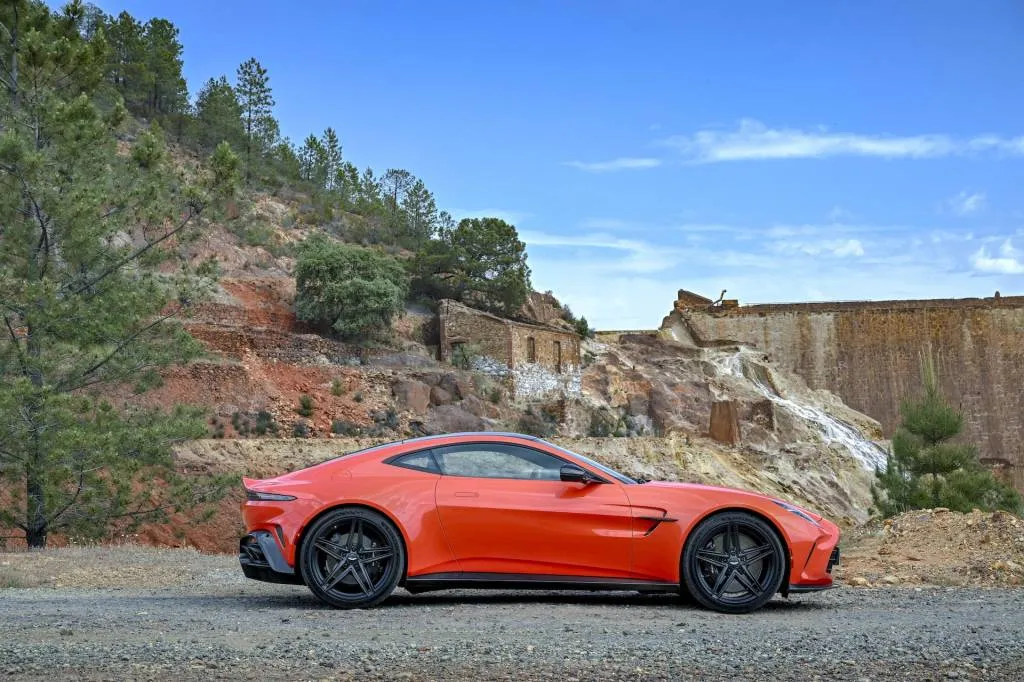
2025 Aston Martin Vantage

2025 Aston Martin Vantage
Aston Martin Vantage road drive
Under CEO Lance Stoll Aston Martin aims to go even further upmarket, with not only performance on par with Ferrari and McLaren but luxury in the vein of Rolls-Royce and Bentley. A road drive reveals that while the performance is on the mark, luxury isn’t, and I don’t think it should be.
Rolls and Bentley hand-craft the most beautiful automotive interiors on the planet, and the Vantage’s cockpit simply can’t measure up. It comes standard with comfortable and supportive heated sport seats, fantastic haircell leather upholstery (which shows the hair follicles), Alcantara instrument panel trim, and satin chrome interior jewelry. My test car switches out the Alcantara IP trim for carbon-fiber and adds Alcantara seat inserts. It’s all elegantly designed and well assembled, but it doesn’t reach Rolls and Bentley levels.
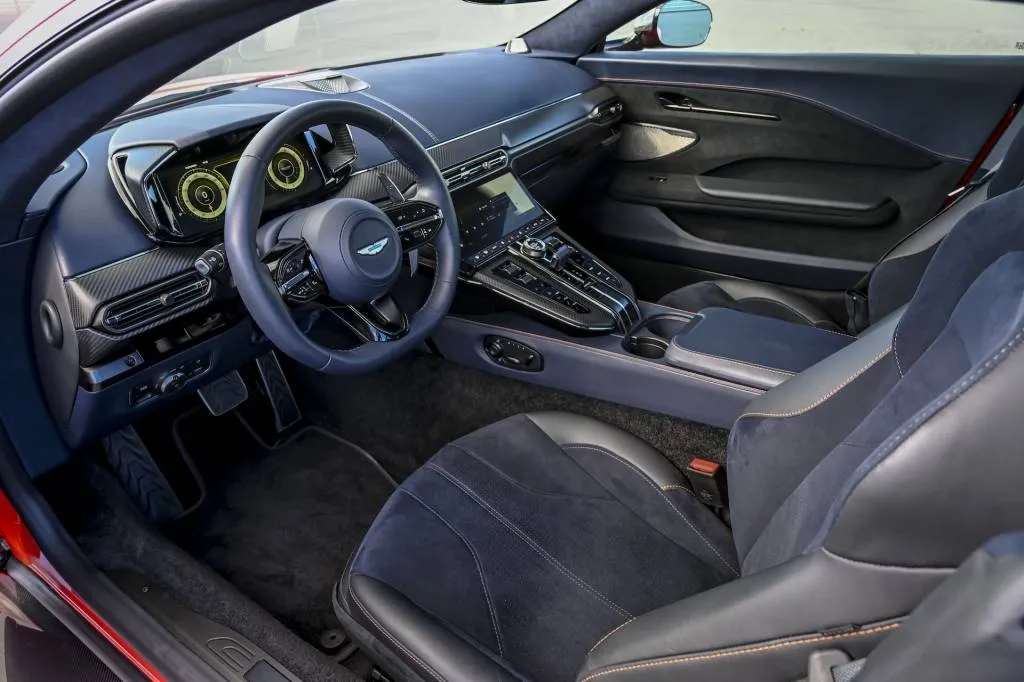
2025 Aston Martin Vantage
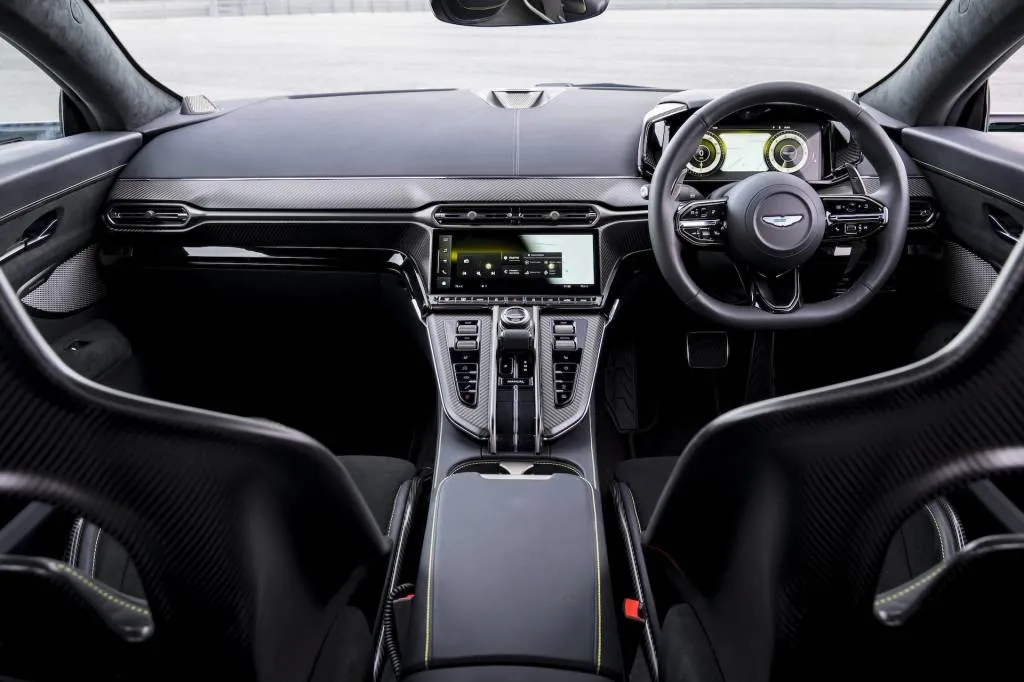
2025 Aston Martin Vantage
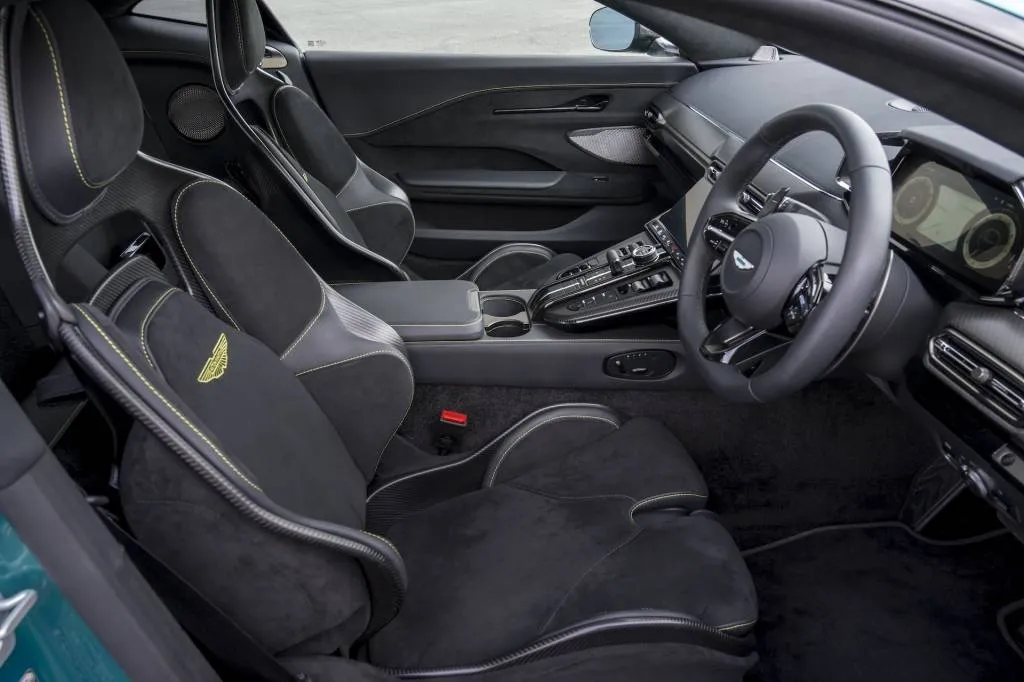
2025 Aston Martin Vantage
Neither does the sound deadening. The Vantage lets in lots of road noise from those wide rollers, which also doesn’t scream luxury but is appropriate for a sports car. Besides, I want to hear the deep rumble of the V-8, as well as the pops and crackles on overrun in Sport+ and Track modes.
The cabin also features a new infotainment system developed in-house and teamed with a 10.3-inch touchscreen. Given that my drive consists of track time and twisty roads, I don’t pay much attention to how well the system works, but I do notice that it has small app icons and it seems to take a beat to react to inputs. It’s likely an improvement over the old Mercedes-based system, but it’s not as quick or likely as deep as today’s best systems.

2025 Aston Martin Vantage
But the Vantage isn’t about infotainment. It’s about driving entertainment, and it delivers on that in spades. It takes a quantum leap over the last model in power, grip, and track prowess, and it looks better, too. Priced from $191,000 before destination, the 2025 Aston Martin Vantage provides a well-balanced, front-engine alternative to the likes of the rear-engine Porsche 911 Turbo and mid-engine Chevy Corvette Z06, and it does so with a charming British elegance. The new Vantage should be approached with respect, but it’s damn fun building up the confidence to harness its expanded performance envelope, even if you’re driving in the wet on the wrong side of the car.
Aston Martin paid for travel, lodging, and track time for Motor Authority to have a blast sliding around in the new Vantage.
